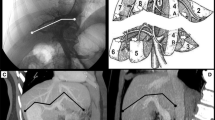Abstract
Background
Successful liver surgery requires an understanding of the patient’s particular liver characteristics, including shape and vessel distribution. In clinical medicine, there is a high demand for surgical assistance systems to assess individual patients. Our aims in this study were to segment the liver based on computed tomography volume data and to develop surgical plans for individual patients.
Methods
The hepatic vessels were semi-automatically extracted from the segmented liver images, and the 3D shape of the liver and extracted vessel distribution were visualized using a surgical simulation system.
Results
The 3D visualization of the liver allowed easy recognition of vessel and tumor location and selection of these structures with the 3D pointing device. The surgeon’s prior knowledge and clinical experience were integrated into the visualization system to create a practical virtual surgery, leading to improved functionality and accuracy of information recognition in the surgical simulation system.
Conclusions
The 3D visualization demonstrated details of individual liver structure, resulting in better understanding and practical surgical simulation.










Similar content being viewed by others
References
Amir H. Foruzan, Yen-Wei Chen, Zoroofi RA, et al.: "Multi-mode Narrow-band Thresholding with Application in Liver Segmentation from Low-contrast CT Images," Proc. of 2009 Fifth International Conference on Intelligent Information Hiding and Multimedia Signal Processing, pp.1293-1296, 2009.
A. F. Frangi, W. J. Niessen, K. L. Vincken, et al.: Multiscale vessel enhancement _ltering Proc.1st MICCAI, pp. 130–137, 1998.
Munkres, James; Topology (2nd edition). Prentice Hall, 1999.
V. Caselles et al. “Geodesic Active Contours,” International Journal of Computer Vision, Vol.22, pp.61-79, 1997
Fuchs J, Warmann SW, Szavay P, et al. Three-dimensional visualization and virtual simulation of resections in pediatric solid tumors. J Pediatr Surg. 2005; 40: 364–70.
Visualization toolkit, http://www.vtk.org/, accessed: 29 July, 2010
K. Miyawaki, Graduation Thesis of Ritsumeikan University, March, 2011
Kruger and Westermann, “Linear algebra operators for GPU implementation of numerical algorithms,” International Conf. on Computer Graphics and Interactive Techniques, 2005
Shen, J. Zhou, A. Hamam, et al., “Haptic-Enabled Tele-mentoring Surgery Simulation”, IEEE Multimedia, pp.64-76, 2008.
MEVIS Medical Solution: http://www.mevis.de/mms/en/index.html
Phantom Omni Haptic Device: http://www.sensable.com/haptic-phantom-omni.htm
Author information
Authors and Affiliations
Corresponding author
Rights and permissions
About this article
Cite this article
Kaibori, M., CHEN, YW., Matsui, K. et al. Novel Liver Visualization and Surgical Simulation System. J Gastrointest Surg 17, 1422–1428 (2013). https://doi.org/10.1007/s11605-013-2262-x
Received:
Accepted:
Published:
Issue Date:
DOI: https://doi.org/10.1007/s11605-013-2262-x




